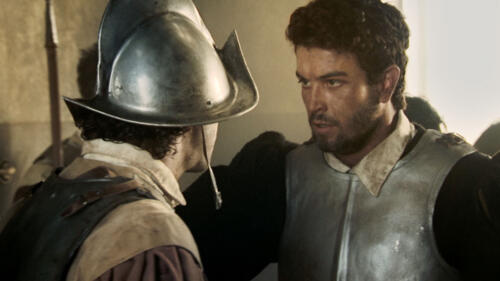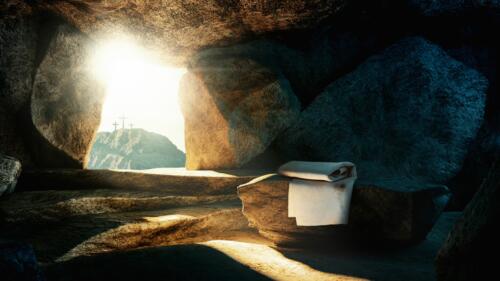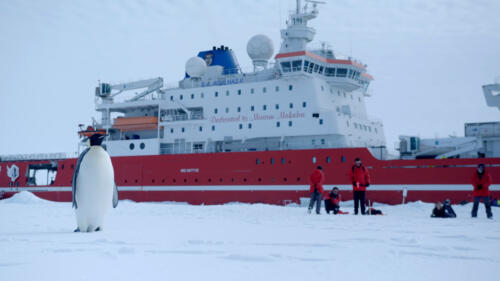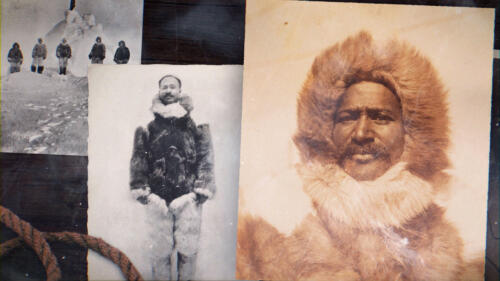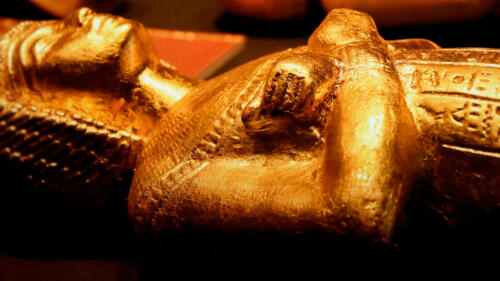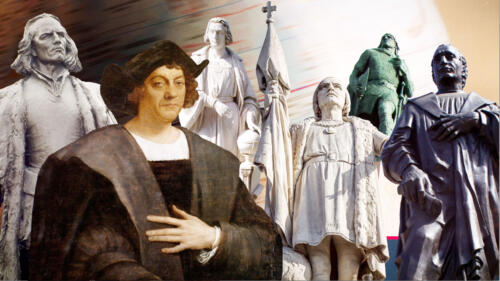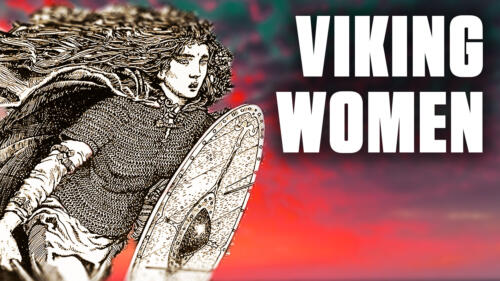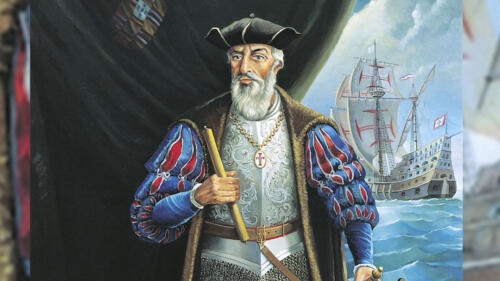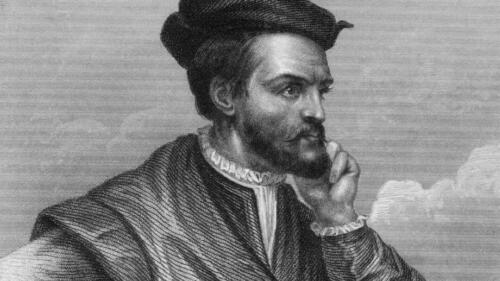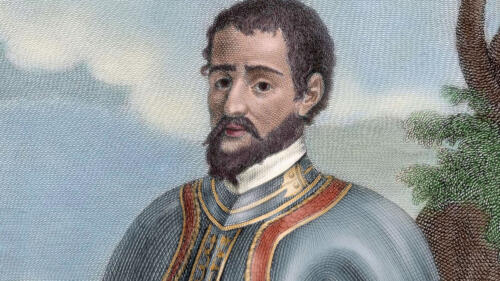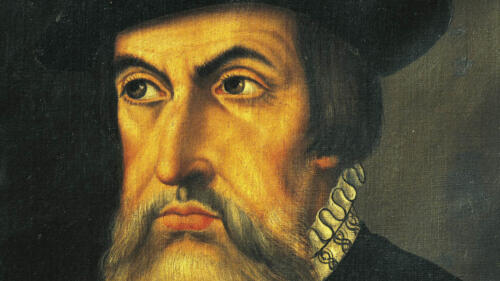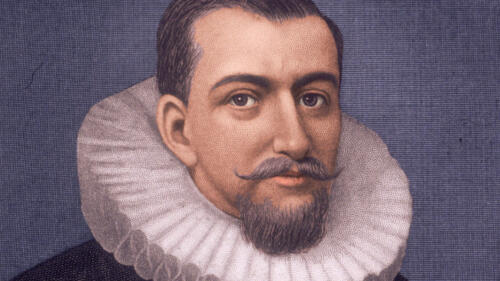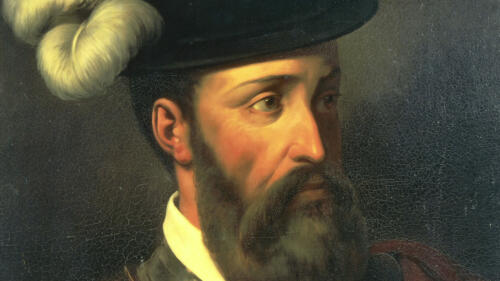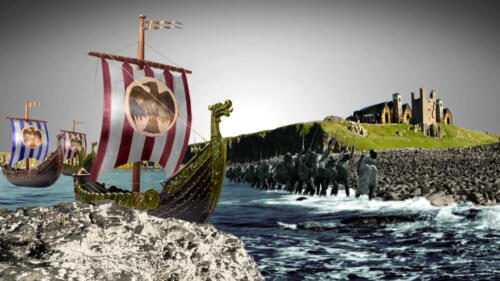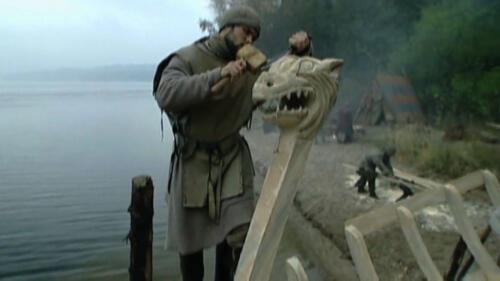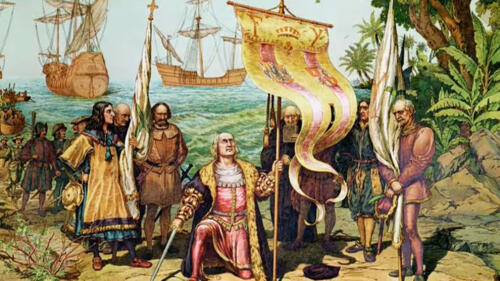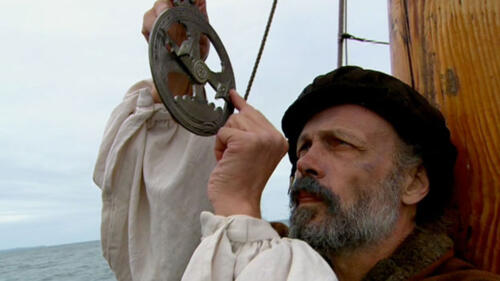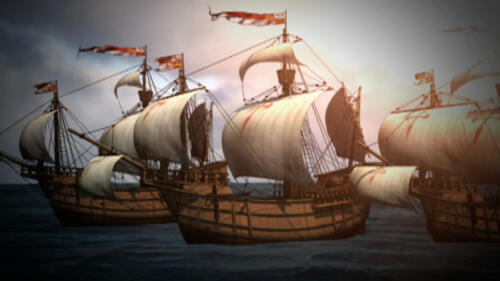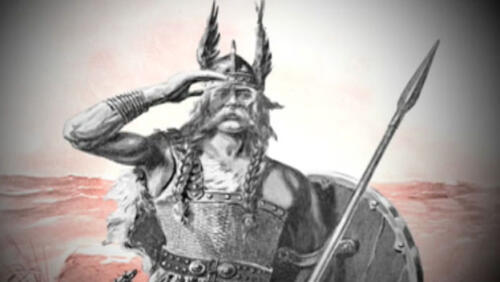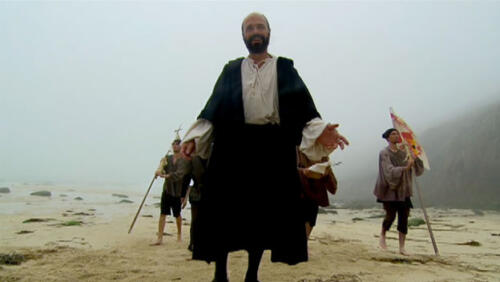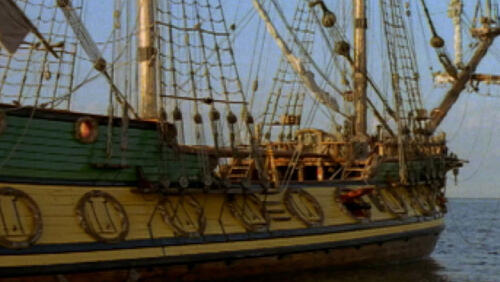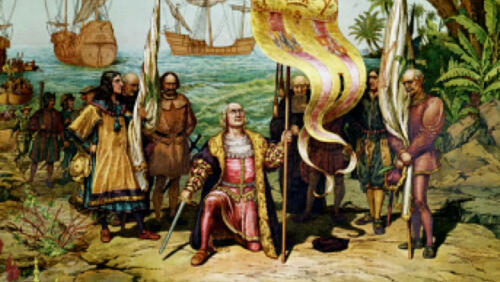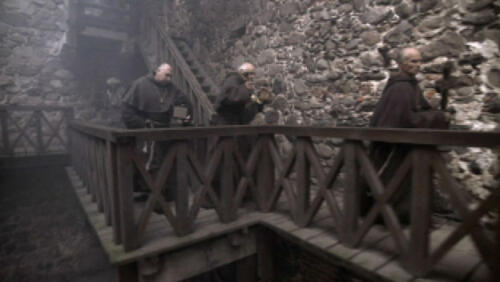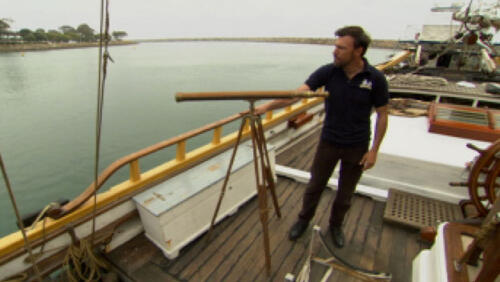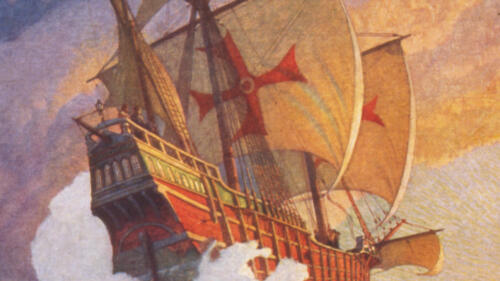Exploration
In the 15th century, Europeans began to sail west across the Atlantic Ocean in search of new routes to China and the East. In the process, they discovered what they labeled a "New World," although Indigenous people had lived there for centuries. Other explorers have pushed the limits of flight and seafaring, and traversed the frozen Continent of Antarctica.

Start Here

These fast ships and navigational tools aided European sailors between the 15th and 17th centuries.

Columbus's famed voyage to the New World was celebrated by Italian-Americans, in particular, as a pathway to their own acceptance in America.

The discovery of Ernest Shackleton's ship at the bottom of Antarctica's Weddell Sea recalls a grueling expedition when men endured entrapment, hunger, frigid weather, angry seas—and near madness.

The encounter between the Spanish explorer and Aztec king changed the course of history. But the story has long been told from one side.
Matthew Henson Conquers the North Pole
More to History: Matthew Henson Conquers the North Pole
Robert Peary is famous as the first explorer to officially reach the North Pole, but Matthew Henson might deserve just as much credit.
3 Famous Explorers
Explore All Related Topics

With the Aqua-Lung, the French oceanographer and filmmaker realized his dream of creating a system to swim and breathe freely underwater.

What were the Vikings doing in Italy and Greece?

The lightweight, paddle-powered boats have served a variety of purposes over thousands of years.

Legends, lies and guesswork once shaped the world’s cartography.

Legendary warrior chief was first Hawaiian to travel the world.

The scourge of mariners from antiquity to the modern era, wood-boring shipworms were purportedly more feared than pirates.

A disastrous 1879 Arctic expedition finally confirmed there was no open ocean at the top of the world—although warming waters could eventually make it possible.

From boots to sleeping bags, see how equipment that Edmund Hillary and Tenzing Norgay used in the first ascent of Mount Everest compares to what climbers use today.

Charles Wilkes' discoveries redrew the map of the world.

Their ranks include daring criminals, a legendary pilot and a powerful union boss. None have been found.

“Shall we be thought mad?” expedition leader Salomon August Andrée wrote in his journal, just before he perished.

The question of who fashioned the precious ivory Lewis Chessmen lingers 800 years after the world’s most famous chess pieces were crafted.

What happened to the Franklin expedition remains unclear, but cannibalized remains were identified as belonging to third-in-command James Fitzjames.

These fast ships and navigational tools aided European sailors between the 15th and 17th centuries.

Amerigo Vespucci was an explorer who helped establish the idea of a New World. The territories of South America and later North America were named in his honor.

In 1519, Ferdinand Magellan set off on an audacious journey around the globe. Find out what made the expedition so dangerous—and why its leader did not survive.

Deadly mistakes doomed these early European settlements.

The encounter between the Spanish explorer and Aztec king changed the course of history. But the story has long been told from one side.

Tens of thousands of shipwrecks lie lost and forgotten on the sea floor—but efforts to locate and explore them have seen great advances.

In the 15th century, a small kingdom with a population of approximately 1 million launched the era of maritime exploration that would transform the world.

Christopher Columbus’ arrival in the Caribbean in 1492 kicked off a massive global interchange of people, animals, plants and diseases between Europe and the Americas.

From hot-air balloons floating over Paris to a dirigible crashing over New Jersey, here are some of the biggest moments of aviation history.

Mythology describes how female valkyrie would greet fallen Viking warriors and lead the boldest to a glorious afterlife.

Frank Hurley's photos were originally intended as scientific documentation of an unexplored continent. Instead, they recorded an epic survival story.

The discovery of Ernest Shackleton's ship at the bottom of Antarctica's Weddell Sea recalls a grueling expedition when men endured entrapment, hunger, frigid weather, angry seas—and near madness.

Columbus's famed voyage to the New World was celebrated by Italian-Americans, in particular, as a pathway to their own acceptance in America.

In 1845, two ships left England to navigate the fabled Northwest Passage connecting the Atlantic and Pacific Oceans. Then they vanished without a trace.

Two of Christopher Columbus’ ships were so small that men had no refuge to sleep and poor food storage led to wormy meals.

This is where 12-century warriors went to unwind.

Evidence suggests slavery may have been more central to the Viking story than previously thought.

The revelation raised questions about the how Vikings may have understood gender roles—as well as gender identity.

Did the mass death of Indigenous Americans cool down the planet?

On the high seas, ships had their own system of “law and order.”

Clothing made from cat pelts was fashionable with Viking warriors.

After Blackbeard met a bloody end in 1718, his severed head became a ghoulish ornament.

Captain George Kendall is believed to be the first among the colonists to be executed, but which crime was he killed for?

The hulking skeletons are believed to have been the descendants of Vikings who colonized northern France and, later, southern Italy and Sicily.

Where Is the Northwest Passage? The Northwest Passage spans roughly 900 miles from the North Atlantic north of Canada’s Baffin Island in the east to the Beaufort Sea north of the U.S. state of Alaska in the west. It’s located entirely within the Arctic ...

Georges Nagelmackers had a dream—and he wasn’t afraid to copy Pullman to achieve it.

After coordinating Drake's hugely profitable raid on Spanish loot in Panama, 'Diego' became the explorer's right-hand man.

Humans have known the earth is round for thousands of years.

It's the first genetic confirmation of a female Viking warrior.

Most Vikings were sent to the afterlife in one of two ways.

American aviator Amelia Earhart not only set flying records, but also championed the advancement of women in aviation.

Aviatrix. Pioneer. Record breaker. Fashion entrepreneur?

In the early 1910s, explorers Roald Amundsen and Robert Falcon Scott engaged in a frantic, and ultimately tragic, race to be the first man to reach the South Pole.

The Vikings coveted Constantinople but could never breach its walls. Only by becoming the personal bodyguards of the Byzantine emperor did the Nordic warriors grab a piece of its wealth.

Ireland appeared to be an easy target for the Vikings, but the politically fractured island’s apparent weakness turned out to be its greatest strength.

The earliest known world map was scratched on a clay tablet in the ancient city of Babylon.

Women in the Viking Age enjoyed more freedom and held more power in their society than many other women of their day.

From the Ark of the Covenant to the Aztec gold of Montezuma, these six historic treasures continue to elude us.

From America’s sixteenth president to a world-famous aviator, these seven historical heavyweights had second careers as inventors.

Explore ten fascinating facts about Queen Elizabeth’s favorite pirate.

Scandinavian roots run deep in Minnesota, and so does the belief among some that the first Vikings who inhabited the state were not of the National Football League variety. The theory that the ancient Norsemen explored Minnesota as much as 1,000 years ago blossomed after Swedish-American farmer Olof Ohman and his son discovered a 200-pound, […]

Despite their barbaric reputation, the Vikings left a legacy of achievements that forever changed the way we speak, travel, exercise—and even groom ourselves.

Learn the stories behind five vessels whose watery graves remain unknown.

Pirate lore is rife with tales of hidden treasure and maps where “X” marks the spot, but there are only a few reliable accounts of buccaneers actually burying their loot. One early example concerns the English privateer Francis Drake. After a 1573 raid on a Spanish mule train, he and his men interred several tons […]

On the 450th anniversary of its founding, get the facts on the oldest U.S. city.

In 1695, Henry Every became the world’s most prosperous pirate—and its most wanted man—after leading a bloody raid on an Indian treasure fleet.

Part of the large cache of treasure recovered from the wreck of a 400-year-old Spanish galleon near the Florida Keys will go on auction early next month.

Take a look back at the criminal careers of five of history’s most formidable seafaring women.

Two hundred forty-five years after he landed in Australia, learn 10 surprising facts about the explorer who vowed to sail “as far as I think it possible for man to go.”

Get the facts on America’s most famous long-distance footpath.

For the first time in a millennium, Iceland will have a shrine honoring the ancient Norse gods once worshipped by the Vikings.

From Erik the Red, who founded Greenland’s first Norse settlement, to Cnut the Great, who ruled a vast empire in northern Europe, find out about six fascinating figures of the Viking Age.

A look back at the big break in the search for the Lindbergh baby’s kidnapper that led to the arrest of Bruno Hauptmann.

The Portuguese explorer Ferdinand Magellan is often credited as being the first person to have circumnavigated the globe, but the reality of his journey is a bit more complicated.

Learn 10 surprising facts about the heroic and controversial life of the aviator known as “The Lone Eagle.”

Find out more about the famous waterway connecting the Atlantic and Pacific oceans.

Explore six incredible stories of people who were stranded in unforgiving territory and lived to tell the tale.

What did these warriors eat to survive in such a forbidding landscape?

Take a tour through some of history’s most notorious pirate havens, and meet the swashbuckling marauders who helped build them.

From a deep-sea pioneer to the man credited with the modern discovery of Machu Picchu, get to know five intrepid explorers.

Find out about some of history’s deadliest—and lesser-known—shipwrecks.

Leif Eriksson Day commemorates the Norse explorer believed to have led the first European expedition to North America.

The blindfolded captive, prodded at cutlass-point out onto a narrow beam dangling over the sea, has been as much a part of pirate lore as the buccaneer snarling “Argh!” However, there is no proof that swashbucklers ever made their enemies and victims walk the plank. Instead, real pirates during the 17th and 18th centuries were […]

Find out how the Spanish explorer's name became inextricably linked with the Fountain of Youth.

Forget almost every Viking costume you’ve ever seen. Yes, the pugnacious Scandinavians probably sported headgear when they marched into battle, but there’s no reason to believe it was festooned with horns. In depictions dating from the Viking age—between the eighth and 11th centuries—warriors appear either bareheaded or clad in simple helmets likely made of either […]

These famous explorers journeyed to the far reaches of the earth, only to never be seen again.

Discover fascinating facts about the life of Marco Polo and his legendary travels to the Far East.

Explore 10 surprising facts about the seafaring Scandinavians.

Explore 10 little-known aspects of one of naval history’s most legendary—and deadly—voyages.

Check out 10 things you may not know about the Genoese explorer who sailed the ocean blue in 1492.

From state-sponsored privateers to outright outlaws, these pirates made their reputations as fearsome raiders.

The advent of cutting-edge forensic technology and DNA analysis techniques can shed new light on many of the world’s most famous (and infamous) disappearances—but only to an extent.

Marco Polo: The Early Years Marco Polo was born around 1254 into a prosperous merchant family in the Italian city-state of Venice. His father, Niccolò, and his uncle Maffeo had left the year before on a long-term trading expedition. As a result, he was ...

Explore theories about Amelia Earhart’s final days—some more plausible than others.

Forever remembered as "Amelia Earhart's navigator," Fred Noonan disappeared with the famous aviator on July 2, 1937.

Amelia Earhart (1897-1939) vanished into thin air sometime in 1939, spawning a number of theories about how and where the famed aviator died.

Leif Eriksson was a Norse explorer, and the first known European to have set foot on continental North America, on what is now called Greenland. He reached North America nearly four centuries years before Christopher Columbus arrived in 1492.

Vasco Nuñez de Balboa was a Spanish conquistador, governor and explorer who helped settle South America and the Pacific coast of Central and South America.

The Portuguese nobleman Vasco da Gama (1460-1524) sailed from Lisbon in 1497 on a mission to reach India and open a sea route from Europe to the East. After sailing down the western coast of Africa and rounding the Cape of Good Hope, his expedition made numerous stops in Africa before reaching the trading post of Calicut, India, in May 1498.

John Rolfe’s Early Life Not much is known about Rolfe’s early life except that he was born around 1585 and was probably the son of a small landholder in Norfolk, England. In June 1609, Rolfe and his first wife, Sarah Hacker, sailed for North America abo...

Sir Walter Raleigh’s Early Life Sir Walter Raleigh was born in 1552 to Walter Raleigh and Catherine Champernowne. He was raised in a farmhouse near the village of East Budleigh in Devon, England. Raleigh studied at Oxford before serving in the Huguenot ...

Sir Francis Drake was an English sailor and pirate who achieved fame fighting against the Spanish Armada, plundering Spanish galleons and traveling around the globe.

Juan Ponce de León was a Spanish explorer who served as governor of Hispaniola and Puerto Rico, and allegedly searched for a Fountain of Youth in Florida.

John Cabot, born Giovanni Caboto, was an Italian explorer and trader who is credited with being among the first Europeans to set foot in the New World of North America.

Francisco Vázquez de Coronado (c. 1510-1554) was a 16th-century Spanish explorer. In 1540, Coronado led a major Spanish expedition up Mexico’s western coast and into the region that is now the southwestern United States.

Jacques Cartier, a French navigator and explorer, led expeditions to North America along the St. Lawrence River and helped France lay claim to modern-day Canada.

Hernando de Soto was a 16th-century Spanish explorer and conquistador who grew rich through slavery and his conquests of the Inca and other Native Americans.

Spanish conquistador Hernán Cortés (1485-1547) traveled to Mexico in 1519, where he eventually overthrew the Aztec empire and helped build Mexico City.

Henry Hudson was an English navigator and explorer who made four trips to North America, encountering the Hudson River, Hudson Bay and other important landmarks.

Francisco Pizarro: Early Life Francisco Pizarro was born in 1474 in Trujillo, Spain. His father, Captain Gonzalo Pizarro, was a poor farmer. His mother, Francisca González, was also of low birth, and was not married to Pizarro’s father. Tempted by tales...

Amelia Earhart was the first woman to fly solo across the Atlantic Ocean. She vanished while trying to circumnavigate the globe in 1937, her plane never found.

Christopher Columbus was an explorer who stumbled upon the Americas and whose journeys marked the beginning of centuries of transatlantic colonization.

Spirit of St. Louis Earlier pilots had crossed the Atlantic in stages, but most planes of the era weren’t equipped to carry enough fuel to make the trip without stopping to fuel up. Lindbergh decided, with the backing of several people in St. Louis, to ...

Bartolomeu Dias (c. 1450-1500) was a Portuguese explorer who became the first European to round the southern tip of Africa.

The Vikings were a group of Scandinavian seafaring warriors who left their homelands from around 800 A.D. to the 11th century, and raided coastal towns. Over the next three centuries, they would leave their mark on much of Britain and the European continent, as well as parts of modern-day Russia, Iceland, Greenland and Newfoundland.

The Vikings Discover the New World The first attempt by Europeans to colonize the New World occurred around 1000 A.D. when the Vikings sailed from the British Isles to Greenland, established a colony and then moved on to Labrador, the Baffin Islands and...

Ferdinand Magellan led the first expedition to circumnavigate the globe and became the first European to cross the Pacific Ocean.
